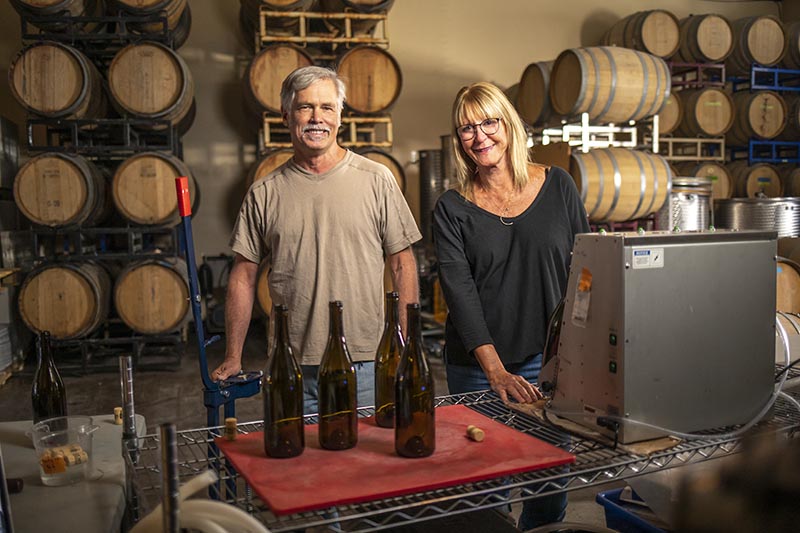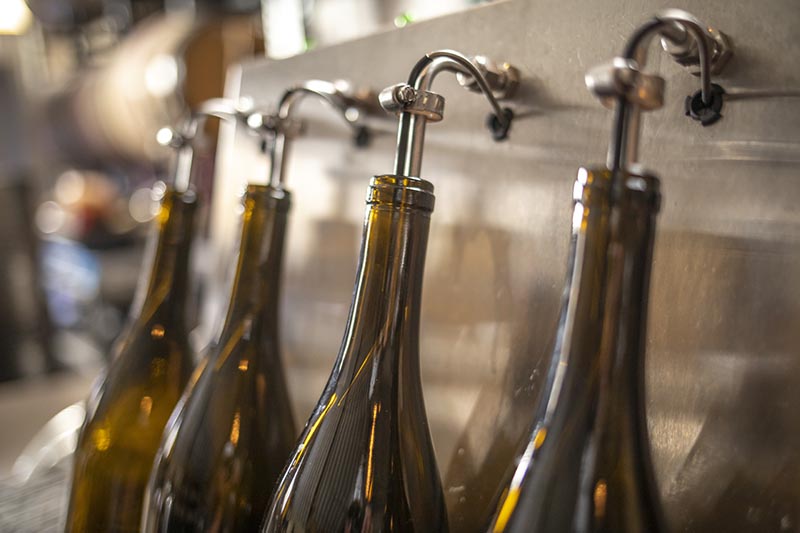State laws restrict potential for a thriving Nevada wine industry.
Running a commercial winery in Nevada means dealing with a lot of red tape. Perhaps that’s why the state only has nine of these enterprises. It wasn’t until 2015 that commercial wineries were even allowed to operate in Clark and Washoe counties. Today, between Nevada’s three-tier regulatory system and its legislation aimed at encouraging in-state grape production, owning a winery this side of the California border can be a tough gig.
Area winemakers say the three-tier system is the problem. The state classifies wineries, distilleries, and breweries into three categories — manufacturers, retailers, and distributors — and subjects each one to different restrictions. Wineries within Nevada only are allowed to operate in two tiers; they can manufacture wine and sell it directly to the consumer from a tasting room, but they may not distribute wine without the use of a third-party distributor (which typically takes a 30 percent cut for its services). As retailers, they may not ship wine to consumers — including wine club members — within Nevada (but they can ship out of state). And as manufacturers, wineries also must adhere to a strict case-sale law.
Sourcing Nevada-Grown Grapes
Specifically, each year, after a wine producer sells 1,000 cases, or 2,380 gallons, of wine it makes with grapes of any origin, the rest of the inventory it sells must be made with at least 25 percent Nevada-grown grapes. Legislators in favor of the law claim it is in place to promote Nevada wine growing and sustainability. However, wineries explain there are financial difficulties associated with meeting the quota.
Alynn Delisle and her business partner, Mike Steedman, owners of Nevada Sunset Winery in Reno (one of four wineries in Washoe County), have exceeded the 25 percent requirement for years. They have been able to consistently incorporate about 30 percent Nevada-grown grapes into their product, but at a high cost.

Most of the grapes Nevada Sunset uses to produce its award-winning vinos come from California — Lodi, Amador County, and El Dorado County — where there is an abundance of grapes in more varietals. This allows Nevada wineries to offer an expansive lineup of wines and those with which consumers are familiar. The average wine drinker, Delisle explains, does not recognize many of the varietals that thrive in Northern Nevada. A great number, she says, are German varietals or hybrids. Steedman and Delisle produced San Francisco Chronicle Wine Competition Best of Class-winning Riesling and gewurztraminer this year entirely from Nevada grapes. Despite this accomplishment, of which they are proud, these wines still don’t sell as well as their Chardonnay, sauvignon blanc, cabernet sauvignon, and other more popular varietals they make with California grapes.
“We need to have marketable varietals and marketable wines,” she says.
John Klacking, a longtime Nevada resident and owner of Double Bond Winery in California’s Central Coast area, says a wide array of varietals can be grown in Northern Nevada’s climate, but getting to the point of having an established and sustainable vineyard of this type is cost prohibitive. Old vines tend to grow better grapes, and even the youngest vines need three to five years to turn out a decent product. That means, once an initial investment is made in vineyard production in Nevada, it’s a waiting game before profits can start rolling in. In the meantime, the wineries making these investments would have a hard time covering expenses.
“If the public wants an industry here, then we need to have a law that states we can make more than 1,000 cases from out-of-state grapes before having to start using Nevada-grown grapes. This is a fraction of what brewpubs can make,” Klacking explains. In fact, the 1,000-case restriction as well as Nevada’s limitations on tasting rooms are the two main reasons Klacking hasn’t brought a winery to the state he’s lived in for more than 30 years.
“You can get a very small production off the ground, but nobody is going to invest a lot of money until the laws change,” he says.
Stuart Michele, head of Nevada Grape Growers and Winemakers, is helping advance favorable legislation, and he has a vested interest. With more than 300 vines planted on his Washoe Valley property, the avid home winemaker would love to move into commercial sales.
“The regulations and the laws are so restrictive in Nevada, it just makes it really hard for a newcomer to make it,” he says.
Last year he was given 250 pounds of grapes from Silver Springs Vineyards near Carson Valley and purchased another 1,250 in Amador County. As a result, if he were to go commercial, Michele would not qualify to sell more than 1,000 cases of his wine.
Delisle and Steedman have long acquired grapes from four Northern Nevada vineyards, but the owners of two of them, at University of Nevada, Reno and Frey Ranch in Fallon, tore them out. That leaves Nevada Sunset with just two vineyards in the state from which to harvest grapes, and together they can’t supply the winery enough grapes for it to meet the 25 percent threshold. The vineyard owners aren’t to blame. Steedman says not only is it a big financial investment to start and run a vineyard, but also, Northern Nevada winters make the proposition risky and uncertain.
“There’s really not a consistent or large source of that fruit available to be able to grow your winery [grapes],” says Dennis De La Montanya, who owns De La Montanya Vineyards in Healdsburg and was approved two years ago to open a winery in Nevada.
At the same time, sourcing grapes from Southern Nevada is an economic and logistical nightmare.
A Place to Taste
Klacking’s comments point to another challenging regulation that all production and tasting must be conducted on site for wineries not grandfathered into the legislation before 2015 (when urban wineries were prohibited in Washoe and Clark counties). In other words, a tasting room can only exist where wine production occurs; no second location for a tasting room is allowed.
Storing, producing, and bottling wine take a lot of space, and a tasting room needs foot traffic to do well. The ability to have an industrial space for production and storage as well as a smaller space for a tasting room in, say, a commercial area — one location shared by several wineries even — makes the financials of running a winery more reasonable.
“It’s much easier in California,” Klacking says. “California is much more conducive [to this idea].”
Distribution Woes
De La Montanya delayed his plans to open a Nevada winery because of COVID-19 and to take time to learn state regulations.
“I was actually surprised and disappointed that they were so restrictive,” he says of the laws. “Nevada, which you would think would be a less restrictive state, actually has more restrictions than California.”
He has since decided to move forward, but has not yet been able to find affordable land in Washoe County that can support a vineyard.
De La Montanya’s business is 99 percent direct-to-consumer, and he ships 50 percent of his product. The ban on in-state shipping and restrictive distribution laws are forcing him to revise his business model.
“Most distributors are not going to want to carry products from a small boutique winery,” he says.
That’s a problem Delisle and Steedman have run into already.
“We have to go through a distributor to get our wine anywhere outside the tasting room,” Delisle explains.
After being turned down by industry gorilla Southern Glazer’s Wine & Spirits, Nevada Sunset’s owners began relying on a friend with a distributor’s license to get their wine into stores and restaurants. The friend’s role, however, is that of a proxy only. In fact, when Delisle gets an order, she calls the distributor to create an invoice, pays him a percentage, and then sets up delivery.
“We really do all our own selling and we just use him … because we have to,” Delisle says. As a result, Nevada Sunset loses revenue because it can’t distribute its own wine.
Pushing Back
Breweries and distilleries have regulations placed on them as part of the three-tier system, too, but most are not as strict. For example, breweries may source their ingredients from wherever they choose. Brewpubs also are allowed to have production facilities separate from tasting rooms, sell 40,000 barrels or 1.24 million gallons of their product with zero requirements that the agricultural products be grown in state, and open more than one tasting room. Craft distilleries can sell 10,000 cases locally and 40,000 exported cases with zero local agricultural product required.
A recently proposed bill, AB-375, which had local and commercial winemaker support, would have raised the limit from 1,000 cases to 2,000 cases (the number that could be sold before the 25 percent Nevada-grown grapes requirement kicked in). However, the bill stalled when the vice chair of the committee didn’t put it up for a vote before the April deadline.
Now, wineries are attempting to piggyback on SB-307, a distributor-supported senate bill, by adding some components that make the boutique winery business easier. The bill aims to strengthen franchise laws and add another 20,000 barrels to the maximum number breweries can sell out of state. Ultimately, winery owners and those interested in opening wineries in Nevada would like to get their own bill back in front of legislators in 2023 when the Nevada Legislature meets again. The goal is to find legislators who support the nine Nevada wineries (and two meaderies), which are treated as wineries under the law) and form a stronger coalition, perhaps with lobbyist support. (Edible Reno-Tahoe attempted to reach a local distribution representative for comment about support for the existing laws, but he did not wish to offer comment at this time.)
Michele says in order to grow the wine industry in Nevada, we should take a page out of the state of Washington’s book (the state is now home to more than 1,000 wineries) and abolish the three-tier system.
“The distributors really own and control the market,” he says. “There are probably thousands of little wineries in the country that don’t get represented.”
Nevada ranks 50 out of 50 states for quality, ease of, and friendliness to wine production, Michele says. Loosening the laws would also encourage California wineries to expand into Nevada, ultimately creating a more lucrative wine industry here and increasing the accessible resources for current Nevada wineries.
The goal was for wineries to get some of their proposals into SB-307, but the additions failed to pass, meaning the newfound freedom that would allow commercially licensed Nevada wineries to increase production and sales, open production facilities off site, and sell other alcohol in their tasting rooms, won’t be realized until at least 2023.
“There’s a huge demand for wine in Washoe County. We have a number of wine club members from Northern Nevada,” De La Montanya says. “We feel that we could be successful. We just need the regulations to allow us to be successful.”
Nora Heston Tarte is a freelance writer in the Reno-Tahoe area and California with a serious passion for wine, as well as a habitual wine club member. You can follow her exploits on Instagram @Wanderlust_n_wine.
SIDEBAR
If you’d like to purchase wines from wineries in Northern Nevada, visit the following tasting rooms:
Basin and Range Cellars
415 E. Fourth St., Ste. B, Reno
775-750-2427 • Basinandrangecellars.com
Engine 8 Urban Winery
1260 Avenue of the Oaks, Ste. 150, Sparks
775-277-6304 • Engine8urbanwinery.com
Great Basin Winery
415 E. Fourth St., Reno
775-399-1057 • Greatbasinwinery.com
Kruze Rd Winery
250 Kruze Road, Lovelock
775-223-9012 • Kruzerdwinery.com
Nevada Sunset Winery
415 E. Fourth St., Ste. B, Reno
650-714-6168 • Nevadasunsetwinery.com



